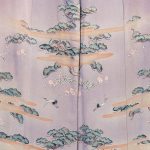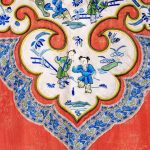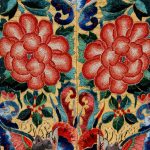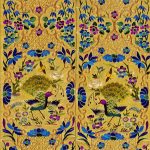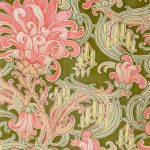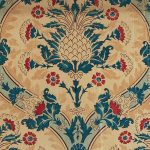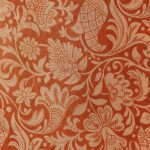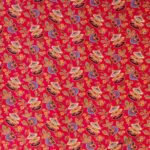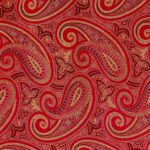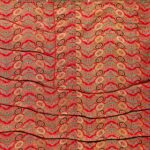Japanese hiki-furisode-style robe, of ombre dyed silk crepe with padded hem and long sleeves and lined with bright red silk. The robe has blank spaces for crests in the small circles either side of the front opening. The beautiful mauve ombre provides a backdrop for the delicate painted motifs depicting auspicious cranes along with pine […]
View moreLeek embroidery was a style of embroidery created and popularised by Sir Thomas and Lady Elizabeth Wardle through the Leek Embroidery Society. Thomas Wardle was an influential silk dyer with a particular interest in Indian silks and natural dyes that influenced his research and experimentation with dyeing processes and materials. He worked alongside several key […]
View moreThis Qing era robe has a typical straight cut, loose fitting body with square sleeves. The simple shape is designed to make efficient use of narrow widths of silk so that as little as possible of the expensive silk fabric is wasted when the garment is constructed. The main fabric is a lightweight silk with […]
View moreSleeve bands were decorative cuffs and would have decorated the bottom edges of the sleeves on a traditional robe. They often featured designs that were a near perfect mirror image of one another so that when the hands were clasped in front of the body and tucked slightly into the opposite sleeve, the designs would […]
View moreSleeve bands were decorative cuffs and would have decorated the bottom edges of the sleeves on a traditional robe. They often featured designs that were a near perfect mirror image of one another so that when the hands were clasped in front of the body and tucked slightly into the opposite sleeve, the designs would […]
View moreA commercial sample of a furnishing weight cotton chintz with an Art Nouveau style pattern designed by Samuel Rowe and printed by Turnbull & Stockdale Ltd. The stylised, intricate and sinuous forms of the flowers in this design are typical of the evolving styles at the end of the 19th century, when Arts & Crafts […]
View moreThis sample of glazed cotton cretonne furnishing fabric was designed by Lewis Foreman Day (b.1845 d.1910). Day was an influential designer, critic and artist who combined the design principles of the Arts & Crafts Movement with industrial production methods. From the 1870s to his death in 1910 he was Artistic Director of the printing firm […]
View moreLightweight cotton furnishing fabric called ‘Salangore’, designed by Thomas Wardle for Liberty. The Victoria & Albert Museum has a sample of this design in blue, printed onto tussah silk hand-woven in India, which was exhibited in the British India Pavilion of the Paris Universal Exhibition of 1878. One of six Indian-inspired patterns at the exhibition, […]
View moreThis piece of roller printed cotton has a stylised floral pattern with a slight paisley influence, seen especially in the small patterns used as fillings for larger shapes. The small scale of the printed pattern and light-weight cotton fabric indicate this was probably intended for use as a dress fabric, although this length appears to […]
View moreThis piece of Turkey Red dyed cotton has been crudely made up into a curtain with a simple drawstring along the top edge, probably not the original intended use for the fabric and more likely a way of making use of a leftover piece of dress fabric. The print used on the fabric is a […]
View moreA full-length petticoat made from brightly coloured printed cotton in vibrant Turkey Red, green and yellow. The lower part of the petticoat is quilted in deep wavy bands decorated with narrow braid and each band is filled with down feathers. As well as being a lightweight but incredibly warm garment these down petticoats also had […]
View moreThis commercial sample still has an unknown manufacturer’s label attached to the top edge, along with three swatches showing the same design on different coloured backgrounds. The complex and stylised floral pattern borrows heavily from Indian chintz designs but uses a colour palette more contemporary to the late 19th century; incorporating a lot more green […]
View more